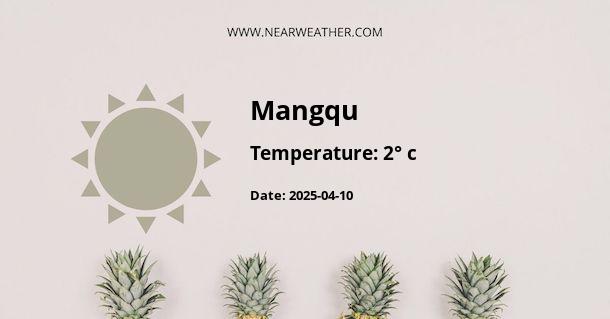Mangqu, China: A Comprehensive Guide to Its Climate and Weather Year Round
Mangqu, located in the Qinghai province of China, is known for its unique climate and diverse weather patterns throughout the year. Understanding the weather in Mangqu is essential for residents, tourists, and businesses operating in the region, as it plays a significant role in daily life and activities. This comprehensive guide provides detailed insights into the climate and weather of Mangqu, covering each season's characteristics, average temperatures, precipitation levels, and more.
Climate Overview
Mangqu experiences a cold semi-arid climate, characterized by relatively low precipitation and a large temperature variation between day and night. The region is situated at a high altitude, which greatly influences its climate patterns. The climate is influenced by its proximity to the Tibetan Plateau and the surrounding mountain ranges, resulting in distinct seasonal changes and unique weather phenomena.
Seasonal Weather Patterns
Understanding the seasonal weather patterns is crucial for planning any activities or visits to Mangqu. Let's delve into the weather characteristics of each season:
Spring (March to May)
Spring in Mangqu is relatively short but marked by a gradual transition from the cold winter months to milder temperatures. Average temperatures during this season range from 5°C to 15°C, with occasional temperature fluctuations. Spring brings relatively low precipitation, making it an ideal time to explore the region's natural beauty and outdoor attractions.
Summer (June to August)
Summer in Mangqu is mild and relatively comfortable, with average temperatures ranging from 15°C to 25°C. The region experiences increased rainfall during the summer months, contributing to its lush green landscapes. However, due to its high elevation, the summer nights can still be chilly, requiring visitors to pack accordingly.
Autumn (September to November)
Autumn is particularly stunning in Mangqu, as the surrounding mountains and valleys are adorned with vibrant foliage. The temperatures start to drop, with average highs ranging from 5°C to 15°C. This season is relatively dry, and visitors can enjoy clear skies and crisp air while taking in the breathtaking fall colors.
Winter (December to February)
Winter in Mangqu is characterized by cold temperatures and occasional snowfall. Average temperatures range from -10°C to 0°C, with the region experiencing frosty conditions. Visitors should be prepared for cold weather and snow-covered landscapes, making it an ideal time for winter sports enthusiasts to explore the area.
Average Temperatures and Precipitation
It's essential to have a clear understanding of the average temperatures and precipitation levels in Mangqu to plan activities and make necessary preparations based on the weather conditions. The following table provides a comprehensive overview of the average monthly temperatures and precipitation levels in Mangqu:
| Month | Average Temperature (°C) | Precipitation (mm) |
|---|---|---|
| January | -8.3 | 1 |
| February | -5.8 | 2 |
| March | 0.7 | 4 |
| April | 7.5 | 11 |
| May | 12.6 | 24 |
| June | 16.1 | 53 |
| July | 17.8 | 100 |
| August | 16.8 | 92 |
| September | 12.2 | 47 |
| October | 6.0 | 18 |
| November | -2.0 | 4 |
| December | -7.4 | 1 |
The table illustrates the fluctuation of temperatures and the variation in precipitation levels across the different months in Mangqu. It's evident that the region experiences distinct seasonal changes, influencing outdoor activities and local agricultural practices.
Extreme Weather Events
While Mangqu generally experiences predictable seasonal changes, the region is also susceptible to occasional extreme weather events such as blizzards and strong winds, especially during the winter months. These events can impact transportation, agriculture, and overall daily life in the area. Residents and visitors should stay informed about weather forecasts and advisories to ensure their safety and preparedness during such occurrences.
Climate Change and Its Impact
Climate change poses significant challenges to regions like Mangqu, with potential implications for its natural ecosystems, agriculture, and water resources. It's crucial for local authorities and stakeholders to monitor and adapt to the evolving climate patterns to mitigate the impact of climate change on the region's overall sustainability and resilience.
Conclusion
Mangqu's climate and weather patterns exhibit a remarkable diversity across the four seasons, offering a range of experiences for residents and visitors throughout the year. Understanding the climate and weather characteristics is essential for making informed decisions and ensuring preparedness for any outdoor activities or travel plans in the region.
By embracing sustainable practices and adapting to climate change, Mangqu can continue to thrive while preserving its natural beauty and unique environment for future generations to appreciate and enjoy.
A - Mangqu's Latitude is 35.585701 & Longitude is 100.752373.
A - Weather in Mangqu is 2° today.
A - Climate Conditions in Mangqu shows broken clouds today.
A - Humidity in Mangqu is 26% today.
A - Wind speed in Mangqu is 10.62 km/h, flowing at 190° wind direction. today.
